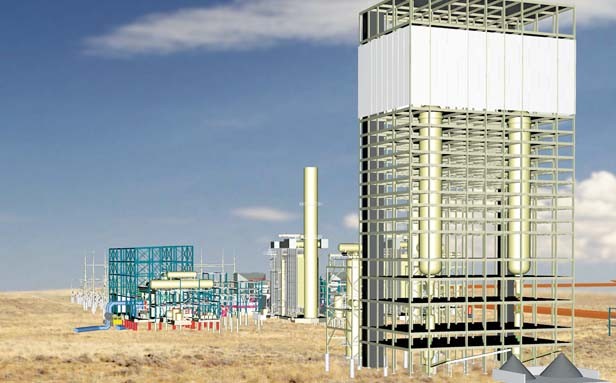
The Illinois Senate recently approved a controversial proposal to build a cutting-edge coal power plant in Taylorville, paving the way for what proponents say should be an easy victory in the Illinois House. But critics say the project is unnecessary and puts the cost and risk on taxpayers.
The proposed Taylorville Energy Center would create electricity by turning Illinois coal into a combustible gas, while capturing some of the resulting carbon dioxide and other pollutants. The captured CO2 would be injected deep underground, while pollutants like sulfur and mercury would be isolated and sold for industrial uses. About 1.9 million tons of CO2 from the Taylorville plant would be captured each year, out of a total expected 3.45 million tons produced annually.
The project, a joint venture by Omaha, Neb.-based Tenaska and MDL Holding Co. of Louisville, Ky., is slated as a “clean coal” alternative to older coal power plants because of the reduced emissions. It would be the first power plant of its kind anywhere, Tenaska says.
On Nov. 29 the Senate passed Senate Bill 678, which would make the Taylorville plant eligible for a tax credit worth an estimated $8.7 billion over 30 years. Previous versions of the bill have failed multiple times because of objections from environmental groups, business groups and competing energy companies.
The bill would require energy suppliers like Ameren Illinois and Commonwealth Edison to buy power from the Taylorville plant, which would supply about 2.5 percent of the state’s electricity. The bill puts a partial cap on energy price increases charged to large industrial customers, and it would require Tenaska to absorb two thirds of any cost overruns involved in the plant’s construction.
Critics of the project, such as the STOP (Stop Tenaska’s Overpriced Power) Coalition, say the project is an unnecessary and expensive boondoggle, the cost of which shouldn’t fall on taxpayers. STOP estimates that the price of energy from the Taylorville plant is expected to be $286 million higher per year than current electricity prices.
But Tenaska spokesman Dave Lundy says that by the time the Taylorville plant is finished in late 2016 or early 2017, the cost of energy will have risen dramatically, making Tenaska’s proposal more economical.
Lundy said the higher energy prices are already a reality for the future. He explains that prices in the energy industry’s “capacity payments auction” – an auction in which energy suppliers bid for anticipated future electricity output from energy generators – have skyrocketed 354 percent this year. That increase was driven by projections that many older coal power plants will close soon because of stricter pollution regulations, Lundy says, citing a study by research firm Wood MacKenzie. The study shows 239 coal plants nationwide are slated for closing, taking an estimated 40 gigawatts of power generation capacity offline, Lundy says.
Kevin Wright, president of the Illinois Competitive Energy Association, says a different study from the U.S. Environmental Protection Agency doesn’t raise any alarms about coal plant closures.
“At this point, it’s Tenaska’s projection,” Wright said. “We think they use it as a scare tactic to justify the need. Based on EPA studies, there is no evidence there will be closures as dire and widespread as Tenaska claims.”
He said the capacity payment increase is a red herring because prices have actually dropped in previous years.
“This latest increase will basically put consumers back on the same footing they were on a few years ago,” he said, adding that Illinois already exports excess energy to other states.
“We are the fourth largest exporter in the country,” Wright said. “The last study showed we generated about 30 percent more than our consumers needed. We operate in a regional marketplace, so Illinois is not an electric island.”
Despite the lingering disagreement over the project’s usefulness, Lundy said the House will likely approve the plan if it is called for a vote when lawmakers return to Springfield in January.
“Passing the Senate was a huge milestone,” Lundy said. “We passed the House before with a bill that didn’t include all of these environmental protection provisions, and the bill has only gotten meaningfully better, so it’s reasonable to assume that it will pass again in the House.”
Barry Matchett, co-legislative director for the Environmental Law and Policy Center (ELPC) in Chicago, said his group previously opposed the bill. ELPC now supports the revised bill, Matchett said, because it would create tax incentives for “distributed generation” – electricity generation from many small sources such as wind turbines or solar panels. That provision is especially important in this economy, Matchett said, because investment in renewable energy projects has dried up.
The bill also allows the Illinois Power Agency, the state agency which arranges the procurement of electricity between generators and suppliers, to purchase surplus energy created by homes with solar panels, wind turbines or other renewable resources – provided that surplus energy is cheaper than energy generated by conventional means.
“Without that fix to the renewable standard, I suspect that most renewable energy in Illinois would slowly grind to halt,” he said. “This is a big deal, and there are a lot of folks out there who are focused only on the coal plant element of the bill, but to us, the renewable piece frankly trumps the coal piece.”
Jack Darin, director of the Sierra Club Illinois Chapter, said most environmental groups still oppose the project. While he applauds the renewable energy provisions of the bill, he said the project itself would still increase pollution.
“We don’t think we should have to swallow 30-year contracts and underwrite one of the largest sources of pollution in Illinois just to update our energy efficiency policies,” Darin said. “We can do that without risk and without billions of tons of pollution, and we should.”
Contact Patrick Yeagle at [email protected].




















